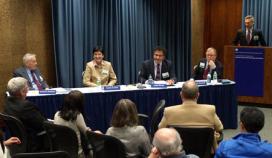Expert Panel Explores Implications of Human-Machine Interactions
Increasingly, humans are being asked to interact with complex automated transportation management and control functions in all modes of transportation. A panel of leading experts convened at Volpe, The National Transportation Systems Center, on April 13 to discuss key safety and policy issues pertaining to the planning, implementation, and unintended consequences of automated transportation systems.
The team of experts emphasized that the roles, responsibilities, and authorities of automation and human operators need to be well defined, designed, and introduced upfront.
This panel featured expert presentations from human-automation thought leaders: The Honorable Robert L. Sumwalt, member of the National Transportation Safety Board; Daniel Serfaty, chairman and CEO of Aptima, Inc.; Dr. Nadine B. Sarter, professor of industrial and systems engineering at the University of Michigan; Dr. Thomas B. Sheridan, emeritus, professor of engineering and applied psychology and aeronautics and astronautics at MIT; and Dr. Stephen M. Popkin, director of the Center for Human Factors Research and System Applications at Volpe.
Dr. Popkin moderated a lively question and answer session during this roundtable, "Automation and the Human: Intended and Unintended Consequences," which was part of Volpe's ongoing series of colloquia titled Transportation Safety in a Digital Age. Gregory D. Winfree, acting administrator of the Research and Innovative Technology Administration, and Robert C. Johns, associate administrator and director at Volpe, welcomed and kicked off Volpe's roundtable.
"Automation needs to be designed to make sure the operator is paying attention, not to keep the operator from having to pay attention," explained Sumwalt, who kicked off the day's dialogue and provided a review of what transportation accidents reveal about the role of automation. His analysis showed that humans do not excel at monitoring complex automated systems - even though that is the role they typically play in transportation control functions. Sumwalt illustrated this paradox with an example of a subway conductor who monitors the automation system during routine situations and takes over only when something goes wrong.
Without appropriate training, the tendency for human operators to over-rely on automation can lead to unintended safety consequences, said Serfaty. The disconnect between automation and its human counterparts is particularly acute in terms of responsiveness to unforeseen events. "Because computers can neither adjust to visual communications nor react to emotional cues, automation is far from being at a level where it can be considered an equal 'team member' to human counterparts," Serfaty noted.
Although many transportation automation systems feature warning signals to get the attention of human operators and caution them of danger, research from Dr. Sarter shows that frequent interruptions often break humans' ability to stay on task. Humans need to be able to distinguish between distractions that can be ignored and warnings that need immediate attention. "Automation systems should be designed to take into account that the human may not truly understand how important the distraction is," said Dr. Sarter.
Dr. Sheridan, who has been studying this topic for four decades, agreed. His research outlines typical human response times to emergencies, illustrating that while the majority of people act quickly, some wait and watch before responding. "Automation needs to account for the huge variation in human abilities to respond," Dr. Sheridan said.
During the moderated question and answer period, Dr. Popkin prompted the participants by asking the question, "How do you determine how good is good enough when you are applying automation?"
"This is where humans are going to make the judgment and the automation is not going to decide on when it's good enough..." responded Dr. Sheridan.
There was significant cross-modal and cross-agency engagement in this transportation safety roundtable. Over 200 participants representing six U.S. DOT operating administrations, other federal agencies, state and local transportation officials, industry, labor organizations, and others engaged in person or via webinar.
"This nation has achieved unprecedented gains in transportation safety, reaching historic lows in roadway and aviation fatalities," said Winfree. "New safety technologies - such as seat belts, air bags, and advanced flight control systems - helped pave the way for our success in saving lives and preventing life-changing injuries. Today, we are at a crossroads - on the cusp of a new transportation era. There is no reason to believe that automation and other promising innovations won't lead to even greater milestones in transportation safety, but it's up to us to ensure that this happens," Winfree said.
Volpe's colloquia on Transportation Challenges and Opportunities brings together thought leaders and experts from government, academia, and the private sector to tackle emerging transportation issues and discuss fresh approaches to addressing these issues. Readers can view video clips of past events and subscribe to Volpe news alerts to receive announcements of future events.

Left to right: Thomas B. Sheridan, Ph.D., Emeritus, Professor of Engineering and Applied Psychology (Mechanical Engineering), Professor of Aeronautics and Astronautics, Massachusetts Institute of Technology; Nadine B. Sarter, Ph.D., Professor, Industrial and Systems Engineering, University of Michigan; Daniel Serfaty, Chairman and CEO, Aptima, Inc.; The Honorable Robert L. Sumwalt, Member, National Transportation Safety Board; and Robert C. Johns, Volpe Director. (Volpe photo)
